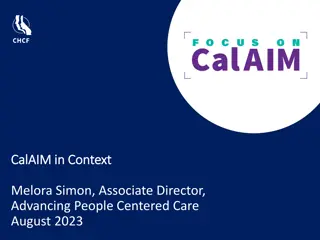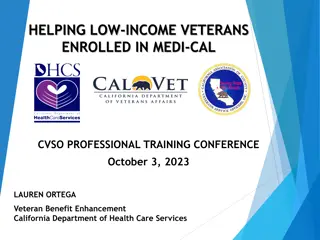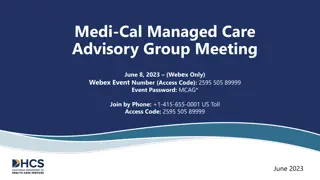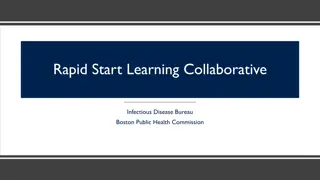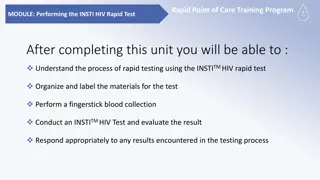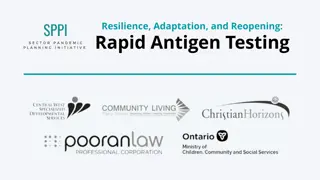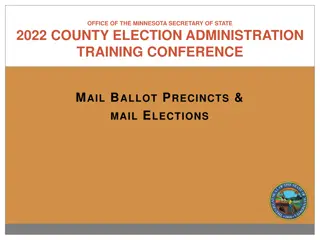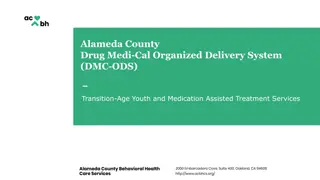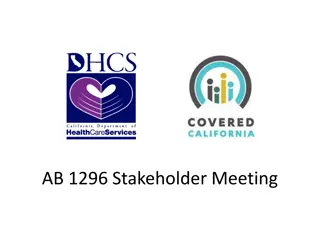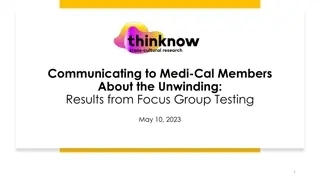Analysis of 2019 Cal MediConnect Rapid Cycle Polling Project Findings
The findings from the Cal MediConnect Rapid Cycle Polling Project conducted in 2019 focused on comparing the experiences of Cal MediConnect (CMC) enrollees by county, race, language, and disability across different characteristics such as language and need for Long-Term Services and Supports (LTSS). The project aimed to provide insights into the integrated health plans created for dually eligible beneficiaries in California. Surveys were conducted through telephone interviews with stratified random samples of CMC enrollees in seven counties to gather data on their medical care coordination and newly provided benefits.
Download Presentation

Please find below an Image/Link to download the presentation.
The content on the website is provided AS IS for your information and personal use only. It may not be sold, licensed, or shared on other websites without obtaining consent from the author.If you encounter any issues during the download, it is possible that the publisher has removed the file from their server.
You are allowed to download the files provided on this website for personal or commercial use, subject to the condition that they are used lawfully. All files are the property of their respective owners.
The content on the website is provided AS IS for your information and personal use only. It may not be sold, licensed, or shared on other websites without obtaining consent from the author.
E N D
Presentation Transcript
INTRO SUMMARY 2019 Findings from the Cal MediConnect Rapid Cycle Polling Project COUNTY RACE LANGUAGE Conducted for The SCAN Foundation LTSS In conjunction with The California Department of Health Care Services APPENDIX Contact Info By Institute for Health and Aging, University of California, San Francisco May 2019
Introduction INTRO Report Objectives SUMMARY Previous reports looked at overall frequencies and compared those in Cal MediConnect (CMC), to those who opted out and those in non-demonstration counties. COUNTY RACE The prime objective of these analyses was to compare CMC enrollees experiences by county, race, language, and disability using the following characteristics: LANGUAGE The seven participating counties: San Bernardino, San Diego, Santa Clara, San Mateo, Orange, Los Angeles, and Riverside LTSS Race: White, Black, Asian/Pacific Islander, and Hispanic/Latino APPENDIX Contact Info Language of survey administration: English, Chinese, and Spanish Need for Long-Term Services and Supports (LTSS): No LTSS need, those with routine needs only, and those with need for personal care assistance 1
Introduction INTRO California s Dual Financial Alignment Demonstration Cal MediConnect SUMMARY Background: In 2014, California implemented a dual financial alignment demonstration called the Coordinated Care Initiative. As part of this demonstration new integrated health plans, called Cal MediConnect (CMC), were created in seven counties for people eligible for both Medicare and Medi-Cal. COUNTY RACE Dually eligible beneficiaries enrolled in CMC had all of their medical care, ancillary services, and long-term services and supports (LTSS) coordinated through one integrated managed care plan. LANGUAGE LTSS CMC enrollees received some new benefits such as care coordination and non-emergency transportation. APPENDIX Contact Info While specialty behavioral health was carved out, mild to moderate behavioral health benefits were provided through CMC, and CMC care coordinators were tasked with coordinating with specialty behavioral health county providers. 2
Introduction INTRO About the Surveys SUMMARY Survey Method Telephone interviews with stratified random samples of dual eligible beneficiaries in Cal MediConnect (CMC) counties COUNTY Populations Surveyed RACE 2015: CMC enrollees in five counties (Los Angeles, Riverside, San Bernardino, San Diego, and Santa Clara) LANGUAGE 2016 through 2018: CMC added two counties (San Mateo and Orange) Sample Sizes of CMC Enrollees by Survey Year 2015: 2,764 CMC enrollees 2016: 3,351 CMC enrollees 2017: 1,779 CMC enrollees 2018: 1,775 CMC enrollees LTSS APPENDIX Contact Info Aggregate Sample Size of CMC Enrollees (across all years) 9,669 CMC enrollees 3
Introduction INTRO CMC Enrollees by County SUMMARY Sample of CMC Enrollees by County and Year COUNTY County 2015 1,021 2016 905 2017 716 2018 827 Los Angeles RACE 429 409 208 144 Riverside 458 399 162 199 San Bernardino LANGUAGE 399 403 226 180 San Diego 457 405 130 111 Santa Clara LTSS 0 526 99 114 San Mateo 0 304 238 200 Orange APPENDIX Contact Info 4
Introduction INTRO CMC Enrollees by Race and Language SUMMARY Sample of CMC Enrollees by Race and Language of Survey Administration and Year COUNTY Race* 2015 2016 2017 2018 645 813 446 349 White non-Hispanic RACE 1,297 1,772 736 800 Hispanic/Latino LANGUAGE 293 324 211 182 Black 262 326 197 254 Asian/Pacific Islander LTSS *Note: Race sample size=8907. Respondents who answered other or not recorded were excluded from the analysis. APPENDIX Contact Info Language of Administration 2015 1,582 2016 2,015 2017 1,181 2018 1,027 English 1,051 1,258 506 581 Spanish 131 78 92 167 Chinese 5
Introduction INTRO CMC Enrollees by Need for Long-Term Services and Supports SUMMARY Sample of CMC Enrollees by Type of LTSS Needs and Year COUNTY LTSS Needs* 2017 2018 No LTSS Needs 1,119 1,076 RACE Routine Care Needs only** 235 215 LANGUAGE Personal Care Needs*** 383 432 * This item about LTSS needs distinguished between no LTSS needs, personal care needs, and routine care needs and was only asked in 2017 and 2018. ** Routine needs were defined as needing help with everyday household chores, doing necessary business, shopping or getting around for other purposes. This category only includes those who need only routine care, and does not include those who need both routine and personal care. *** Personal care needs were defined as needing help with eating, bathing, dressing, or getting around inside the home. Most people who needed personal care also needed routine care. LTSS APPENDIX Contact Info 6
INTRO SUMMARY COUNTY Summary Findings in Brief RACE LANGUAGE LTSS APPENDIX Contact Info 7
Summary Findings in Brief INTRO CMC Enrollees Confidence Navigating Health Care SUMMARY COUNTY Confidence navigating health care was fairly high for all CMC enrollees, and seemed to increase between 2015 to 2018. While there were no significant differences in 2018 by county, there were some significant differences by race, language, and disability. RACE By race, Asian/Pacific Islanders (API) expressed less confidence than White or Black groups in their confidence managing their health conditions, knowing who to call, and getting their questions answered. LANGUAGE By language, English-speaking CMC enrollees were significantly more likely to be very confident on all measures compared to Spanish speakers and Chinese- speaking enrollees. LTSS APPENDIX By disability, those CMC enrollees who had no LTSS needs expressed higher confidence that they could manage their health conditions and that they could get their questions answered compared to CMC enrollees with only routine needs, or those with personal care needs. Contact Info 8
Summary Findings in Brief INTRO CMC Enrollees Satisfaction with Health Care Services SUMMARY COUNTY There were some significant differences across counties in satisfaction with choice of doctors and choice of hospitals by race, language, and disability. By race, there were significant differences across all satisfaction questions. In particular, Latinos were least likely to say they were very satisfied with their choice of doctors and hospitals. Both Latinos and API were least likely to be very satisfied with their ability to call a health provider regardless of the time of day. RACE LANGUAGE By language, English-speaking CMC enrollees were most likely to be satisfied with almost all aspects of their health care compared to Spanish- and Chinese- speaking enrollees. LTSS APPENDIX By disability, CMC enrollees with personal care needs were the most satisfied with the hospitals they could use. Those with no LTSS needs were most satisfied with how long they had to wait to see a doctor when they needed an appointment. Contact Info 9
Summary Findings in Brief INTRO CMC Enrollees Problems Encountered with Health Care SUMMARY There were few differences by county in problems encountered with health care, with the exception of a question only asked of non-English-speaking enrollees about access to interpreters. Those in Santa Clara and San Mateo Counties were the most likely to say they were not provided an interpreter when they needed one. COUNTY RACE LANGUAGE By race, White enrollees were most likely to report misunderstandings about coverage, denied treatment, or that a doctor was not available. In contrast, API enrollees were most likely to report problems accessing interpreters, transportation problems, and trouble communicating with providers. LTSS Language was similar to race in that English-speaking enrollees were most likely to report misunderstandings about coverage, denied treatment, or that a doctor was not available. Chinese speaking enrollees were most likely to report problems accessing interpreters and transportation problems. APPENDIX Contact Info CMC enrollees with personal care needs were more likely than those with routine needs or no needs to report problems in all six areas queried. 10
Summary Findings in Brief INTRO CMC Enrollees Experiences with a Personal Doctor* SUMMARY By 2018, CMC enrollees in San Mateo County were the most likely to say they had a personal doctor. They were also the most likely to say that their personal doctor was the same doctor they had before they transitioned to CMC. COUNTY RACE By race, API CMC enrollees were the most likely to report having a personal doctor and also the most likely to say their doctor was the same that they had before CMC. White CMC enrollees were the most likely to say they had been seeing their personal doctor for a year or less. LANGUAGE Similarly, by language, 100% of Chinese-speaking CMC enrollees said they had a personal doctor and they were the most likely to have been seeing the same doctor since before CMC. LTSS APPENDIX By disability, CMC enrollees with personal care needs were the most likely to say they had a personal doctor and slightly more likely than those with no LTSS needs or routine needs to say they had the same doctor since before CMC. Contact Info * A personal doctor was defined in the survey as the doctor who knows you best and can refer you to other doctors when you need to see a specialist. 11
Summary Findings in Brief INTRO CMC Enrollees Use of Single Care Managers and Personal Care Plans SUMMARY COUNTY There were few differences by county in those who reported having a single care manager,* with the exception that CMC enrollees in San Mateo County who did have a single care manager were the most likely to say their single care manager was from the plan. RACE By race, API were the most likely to report having a single care manager, but the least likely to report having a personal care plan.** Latino and Black CMC enrollees who had a single care manager were most likely to say that the single care manager improved their care a lot. LANGUAGE By language, English-speaking CMC enrollees were the most likely to report they had a single care manager and personal care plan. Chinese speakers who had a single care manager were the least likely to say it had improved their care a lot. LTSS APPENDIX By disability, those with personal care needs were significantly more likely to have a single care manager and personal care plan compared to those with no LTSS needs or only routine needs. Contact Info * A single care manager was defined in the survey as a nurse or other helper from their health plan who serves as their main point of contact and can arrange all aspects of their care. ** A personal care plan was defined in the survey as a plan designed to take into account their health goals, needs and preferences. 12
Summary Findings in Brief INTRO CMC Enrollees Long-Term Services and Supports Needs and Use of In-Home Supportive Services SUMMARY COUNTY There were significant differences by county in the percentage of CMC enrollees getting assistance with care needs, getting In-Home Supportive Services (IHSS), their monthly IHSS hours, and unmet needs for personal care*. RACE By race, API CMC enrollees were the most likely to say that they need assistance with personal care and reported the highest unmet needs. API and Black CMC enrollees were more likely than White and Latino enrollees to report using IHSS. LANGUAGE By language, Chinese-speaking CMC enrollees were the most likely to report having needs for assistance with personal care, using IHSS, and the most likely to report unmet needs for personal care. LTSS By disability, those with personal care needs were most likely to get assistance with personal care, most likely to get IHSS, and had the highest average monthly hours compared to those with fewer needs. They were also the most likely to have unmet needs. APPENDIX Contact Info * Personal care needs defined as: eating, bathing, dressing, or getting around inside the home. ** Routine needs defined as: everyday household chores, doing necessary business, shopping or getting around for other purposes 13
INTRO SUMMARY COUNTY Results by CMC Counties RACE LANGUAGE LTSS APPENDIX Contact Info 14
CMC Counties INTRO CMC Enrollees Confidence Navigating Health Care by County SUMMARY COUNTY CMC enrollees across all counties expressed high levels of confidence in navigating their health care. RACE In 2015, just under half of enrollees in all counties said they were very confident they knew how to manage their health conditions. By 2017, over half of CMC enrollees in most counties said they were very confident, with no significant differences by county. LANGUAGE LTSS A majority of enrollees also said they know who to call if they have a health need or a question about their health. The only year there was a significant difference across counties was in 2017, when San Mateo County had the highest percentage of endorsement at 93% and Los Angeles County had the lowest endorsement at 85%. By 2018, there were no longer significant differences by county. APPENDIX Contact Info 15
CMC Counties INTRO CMC Enrollee Confidence Getting Questions Answered by County - 2018 SUMMARY COUNTY RACE LANGUAGE 81% 82% 83% 84% 89% 89% 90% LTSS APPENDIX 11% 11% 9% 10% 7% 9% 8% 8% 8% 8% 7% 5% 2% 2% Contact Info LOS ANGELES RIVERSIDE SAN SAN DIEGO SANTA CLARA SAN MATEO ORANGE BERNARDINO DON'T KNOW/REFUSED SOMEWHAT CONFIDENT/VERY CONFIDENT NOT AT ALL CONFIDENT/NOT TOO CONFIDENT P-VALUE: 0.043 16
CMC Counties INTRO SUMMARY Personal Doctor by County COUNTY In 2018, for the first time there were differences by county in CMC enrollees who said they had a personal doctor. 100% of San Mateo County enrollees said they had a personal doctor, while 89% of San Diego County CMC enrollees said they had a personal doctor. RACE LANGUAGE In 2016 (the first year that San Mateo County was included), 76% of CMC enrollees in San Mateo County said that they still had the same personal doctor they had before enrolling in CMC. By 2018, San Mateo County was still the highest at 70%, with Orange County the lowest at 59%. LTSS APPENDIX Contact Info 17
CMC Counties INTRO SUMMARY Personal Care Doctor by County - 2016 and 2018 COUNTY % of CMC Enrollees Having the Same Doctor Before Enrolling 76% RACE 71% 70% 70% 69% 67% 67% 65% 64% 64% 62% 61% 60% 59% LANGUAGE LTSS APPENDIX Contact Info LOS ANGELES RIVERSIDE SAN SAN DIEGO SANTA CLARA SAN MATEO ORANGE BERNARDINO 2016 2018 18
CMC Counties INTRO SUMMARY Choice of Providers by County COUNTY In 2018, 91% of San Mateo County CMC enrollees said they were very or somewhat satisfied with their choice of doctors (the highest of all the counties). RACE In 2018, over 90% of San Mateo County and San Bernardino County CMC enrollees said they were very or somewhat satisfied with their choice of hospitals (the highest of all the counties). LANGUAGE LTSS APPENDIX Contact Info 19
CMC Counties INTRO SUMMARY Choice of Doctor by County COUNTY RACE LANGUAGE 82% 85% 85% 85% 87% 87% 91% LTSS 4% APPENDIX 7% 8% 5% 4% 6% 11% 3% 4% 6% 5% 8% 6% 5% 5% 5% 3% 3% 2% SAN 1% 1% LOS ANGELES RIVERSIDE SAN DIEGO SANTA CLARA SAN MATEO ORANGE Contact Info BERNARDINO DON'T KNOW/REFUSED DISSATISFIED/VERY DISSATISFIED NEITHER SATISFIED/VERY SATISFIED P-VALUE: 0.012 20
CMC Counties INTRO Choice of Hospital by County SUMMARY COUNTY RACE LANGUAGE 77% 78% 81% 83% 83% 86% 87% LTSS 5% 5% 4% 3% 5% APPENDIX 5% 5% 3% 2% 7% 6% 6% 2% 13% 12% 11% 11% 3% 8% 6% 3% LOS ANGELES RIVERSIDE SAN SAN DIEGO SANTA CLARA SAN MATEO ORANGE Contact Info BERNARDINO DON'T KNOW/REFUSED DISSATISFIED/VERY DISSATISFIED NEITHER SATISFIED/VERY SATISFIED P-VALUE: 0.019 21
CMC Counties INTRO SUMMARY Specific Problems with Health Care Services by County COUNTY Relatively small proportions of CMC enrollees said they encountered any of six specific problems relating to their health services in the recent past. RACE The only specific problem that was significantly different by county was among non-English-speaking enrollees who were asked if their doctor did not speak their language and an interpreter was not provided. The highest percentages were reported by CMC enrollees in Santa Clara County (36%) and San Mateo County (30%). The lowest percentages were reported in Riverside and San Bernardino Counties (8% and 6%, respectively). LANGUAGE LTSS APPENDIX Contact Info 22
CMC Counties INTRO SUMMARY Specific Problems with Health Care Services 2018 (1) COUNTY LOS ANGELES 13% RIVERSIDE 16% Had a misunderstanding about your health care services or coverage RACE SAN BERNARDINO 17% SAN DIEGO 15% SANTA CLARA 17% LANGUAGE SAN MATEO 12% ORANGE 15% LTSS LOS ANGELES 12% Was denied a treatment or referral for another service recommended by a doctor APPENDIX RIVERSIDE 15% SAN BERNARDINO 11% SAN DIEGO 13% Contact Info SANTA CLARA 17% SAN MATEO 13% ORANGE 16% 23
CMC Counties INTRO SUMMARY Specific Problems with Health Care Services 2018 (2) COUNTY LOS ANGELES 11% RIVERSIDE 9% Transportation problems kept you from getting needed health care RACE SAN BERNARDINO 11% SAN DIEGO 14% LANGUAGE SANTA CLARA 15% SAN MATEO 14% ORANGE 13% LTSS LOS ANGELES 15% APPENDIX RIVERSIDE 20% A doctor you were seeing is not available through your plan SAN BERNARDINO 19% SAN DIEGO 17% Contact Info SANTA CLARA 20% SAN MATEO 15% ORANGE 16% 24
CMC Counties INTRO SUMMARY Specific Problems with Health Care Services 2018 (3) COUNTY 10% LOS ANGELES Had trouble communicating with a health provider because of a speech, hearing or other disability RIVERSIDE 10% RACE SAN BERNARDINO 12% SAN DIEGO 14% LANGUAGE SANTA CLARA 14% SAN MATEO 18% ORANGE 7% LTSS LOS ANGELES 14% Doctor did not speak your language and there was not an interpreter available by county* * P-VALUE: <0.001 APPENDIX RIVERSIDE 8% SAN BERNARDINO 6% SAN DIEGO 13% Contact Info SANTA CLARA 36% SAN MATEO 30% ORANGE 13% 25
CMC Counties INTRO SUMMARY Single Care Manager and Personal Care Plan by County COUNTY There were no significant differences by county in the percent of CMC enrollees who reported having a single care manager or personal care plan. RACE Of those who did have a single care manager in 2018, 88% of San Mateo County CMC enrollees said their single care manager was from the plan (highest %), compared to 56% of Orange County CMC enrollees (lowest %). LANGUAGE LTSS Thirty-five percent of Santa Clara County CMC enrollees who did not have a single care manager said that having one would improve their care a lot. APPENDIX Contact Info 26
CMC Counties INTRO SUMMARY Single Care Manager by County COUNTY % of Enrollees Who Said Having a Single Care Manager Would Improve Their Care a Lot or a Little 35% RACE 33% 30% 28% 28% LANGUAGE 26% 25% 22% 20% 18% LTSS 13% 11% 10% 7% APPENDIX Contact Info LOS ANGELES RIVERSIDE SAN SAN DIEGO SANTA CLARA SAN MATEO ORANGE BERNARDINO A LOT A LITTLE P-VALUE: 0.001 27
CMC Counties INTRO SUMMARY Single Care Manager from the CMC Plan COUNTY % Enrollees RACE 88% 84% LANGUAGE 74% 70% 67% 65% 56% LTSS APPENDIX Contact Info LOS ANGELES RIVERSIDE SAN SAN DIEGO SANTA CLARA SAN MATEO ORANGE BERNARDINO P-VALUE: 0.011 28
CMC Counties INTRO Health and Disability Related Characteristics of CMC Enrollees by County SUMMARY In 2018, there were NO differences in health/disability characteristics by county in the following measures: COUNTY Self-rated health RACE Hospital admissions LANGUAGE Use of mental health services Use of medical equipment and supplies Deaf or serious difficulty hearing LTSS Blind or serious difficulty seeing while wearing glasses APPENDIX Difficulty walking or climbing stairs Difficulty dressing or bathing Contact Info Doing errands alone or visiting a doctor s office or shopping 29
CMC Counties INTRO Getting Services or Assistance with Personal Care and Routine Care by County SUMMARY COUNTY In 2018 there were differences by county in: Getting services or assistance with bathing, dressing, help preparing meals, help doing housework, or grocery shopping. San Bernardino County at 29% and Orange County at 19% were the lowest. RACE LANGUAGE Those with a disability using In-Home Supportive Services (IHSS). Orange and San Diego Counties were the lowest at 15% and 20%, respectively; Los Angeles, Santa Clara and San Mateo Counties were the highest at 34%. LTSS Average number of monthly IHSS hours among users differs significantly by county. Orange County was the lowest at 72 hours, while San Mateo and Santa Clara Counties were the highest at over 100 hours. LTSS NEED There was no significant difference by county in unmet needs reported for personal or routine care. Between 32% and 46% in all the counties reported they could use more help with personal care needs. APPENDIX 30
CMC Counties INTRO Getting Services or Assistance with Routine or Personal Care - 2018 SUMMARY COUNTY % of Enrollees Answering Yes to Routine or Personal Care Needs RACE 82% 81% 80% 79% 79% 77% LANGUAGE 67% 66% 57% 56% 55% 54% 43% 36% LTSS APPENDIX LOS ANGELES RIVERSIDE SAN SAN DIEGO SANTA CLARA SAN MATEO ORANGE Contact Info BERNARDINO Personal Care Needs Routine Care Needs Personal care needs P-VALUE: 0.020; Routine care needs P-VALUE: 0.016 31
CMC Counties INTRO Getting All the Help Needed for Personal Care Needs by County - 2018 SUMMARY COUNTY % Enrollees Who Answered could use more help 46% RACE 45% 43% 41% 37% LANGUAGE 33% 32% LTSS APPENDIX Contact Info LOS ANGELES RIVERSIDE SAN SAN DIEGO SANTA CLARA SAN MATEO ORANGE BERNARDINO 32
CMC Counties INTRO Getting Services or Assistance with Bathing, Dressing, Help with Preparing Meals, Housework or Shopping by County SUMMARY COUNTY 2018 % Enrollees Who Are Receiving Services or Assistance RACE 37% 37% 35% 33% LANGUAGE 29% 23% 19% LTSS APPENDIX Contact Info LOS ANGELES RIVERSIDE SAN SAN DIEGO SANTA CLARA SAN MATEO ORANGE BERNARDINO P-VALUE: <0.001 33
CMC Counties INTRO IHSS Use Among People with LTSS Needs 2017 and 2018 SUMMARY COUNTY % Enrollees Using IHSS 34% 34% 34% RACE 32% 30% 30% 28% 28% 26% LANGUAGE 24% 20% 16% 15% LTSS 11% APPENDIX LOS ANGELES RIVERSIDE SAN SAN DIEGO SANTA CLARA SAN MATEO ORANGE Contact Info BERNARDINO 2017 2018 Asked only of enrollees who report using LTSS, 2017 & 2018 P-VALUE: <0.001 34
CMC Counties INTRO IHSS Use Among People with LTSS Needs SUMMARY COUNTY 2017 2018 County Average Hours per Month Average Hours per Month RACE Los Angeles 87 90 LANGUAGE Riverside 92 87 San Bernardino 86 92 LTSS San Diego 67 91 APPENDIX Santa Clara 111 108 San Mateo 93 113 Contact Info Orange 67 72 Asked only of enrollees who report using IHSS 35
INTRO SUMMARY COUNTY RACE Results by Race LANGUAGE LTSS APPENDIX Contact Info 36
Results By Race INTRO SUMMARY Enrollees Confidence Navigating Health Care by Race COUNTY In 2018, similar to previous years, White and Black CMC enrollees were significantly more likely than Latinos or Asian/Pacific Islander (API) enrollees to say: RACE Very or somewhat confident they know how to manage their health conditions (91% of White and Black enrollees, compared to 77% of Latinos and 75% of API enrollees). LANGUAGE LTSS Asian/Pacific Islanders were also least likely to say: They know who to call if they have a question about their health (82%, compared to 88% of Latinos, 94% of White and Black enrollees). APPENDIX They know how to get their questions answered (51%, compared to 64% of White and 66% Black enrollees). Contact Info 37
Results By Race INTRO Enrollees Confidence Navigating Health Care by Race - 2018 SUMMARY COUNTY ASIAN/PACIFIC ISLANDER 74% Know how to manage your health conditions (% very or somewhat confident) BLACK 91% RACE HISPANIC/LATINO 77% WHITE NON-HISPANIC 91% LANGUAGE ASIAN/PACIFIC ISLANDER 82% Know who to call if you have a health need or question (% yes) BLACK 94% LTSS HISPANIC/LATINO 88% WHITE NON-HISPANIC 94% APPENDIX Can get questions about your health needs answered (% very or somewhat confident) ASIAN/PACIFIC ISLANDER 85% BLACK 94% Contact Info HISPANIC/LATINO 78% WHITE NON-HISPANIC 89% 38
Results By Race INTRO SUMMARY Personal Doctor by Race COUNTY API CMC enrollees were most likely to have a personal doctor (98%). RACE API CMC enrollees were also the most likely to have the same doctor they had before enrolling in CMC (75%, compared to 66% Black enrollees, 60% Latinos, and 53% of White CMC enrollees). LANGUAGE White CMC enrollees were the most likely to have been seeing their personal doctor less than a year (21%). LTSS APPENDIX Contact Info 39
Results By Race INTRO SUMMARY Has a Personal Doctor by Race - 2018 COUNTY 98% 94% 92% 91% RACE LANGUAGE LTSS APPENDIX Contact Info WHITE NON- HISPANIC HISPANIC/LATINO BLACK ASIAN/PACIFIC ISLANDER P-VALUE: 0.002 40
Results By Race INTRO SUMMARY Satisfaction with Health Care Services by Race COUNTY There were significant differences by race for all questions related to satisfaction with care in 2018. RACE Latinos were least likely to say they were very satisfied with their choice of doctors and hospitals in 2018 (only 25% were very satisfied). LANGUAGE LTSS Both Latinos and API were the least likely to be very satisfied with their ability to call a health provider regardless of the time of day. APPENDIX Contact Info 41
Results By Race INTRO SUMMARY Satisfaction with Health Care Services by Race Choice of Doctors 2018 COUNTY RACE LANGUAGE 83% 86% 88% 91% LTSS APPENDIX 5% 5% 5% 3% 9% 3% 4% 6% 5% 3% 2% 1% Contact Info WHITE NON-HISPANIC HISPANIC/LATINO BLACK ASIAN/PACIFIC ISLANDER DON'T KNOW/REFUSED DISSATISFIED/VERY DISSATISFIED NEITHER SATISFIED/VERY SATISFIED P-VALUE: <0.001 42
Results By Race INTRO Satisfaction with Health Care Services by Race SUMMARY Choice of Hospitals 2018 COUNTY RACE LANGUAGE 72% 80% 81% 89% LTSS 8% 2% APPENDIX 4% 6% 3% 7% 19% 4% 13% 5% 6% 3% Contact Info WHITE NON-HISPANIC HISPANIC/LATINO BLACK ASIAN/PACIFIC ISLANDER DON'T KNOW/REFUSED DISSATISFIED/VERY DISSATISFIED NEITHER SATISFIED/VERY SATISFIED P-VALUE: <0.001 43
Results By Race INTRO Satisfaction with Health Care Services by Race SUMMARY Information Given Explaining Benefits 2018 COUNTY RACE LANGUAGE 80% 82% 88% 91% LTSS APPENDIX 8% 6% 4% 3% 7% 3% 3% 9% 5% 5% 4% 1% Contact Info WHITE NON-HISPANIC HISPANIC/LATINO BLACK ASIAN/PACIFIC ISLANDER DON'T KNOW/REFUSED DISSATISFIED/VERY DISSATISFIED NEITHER SATISFIED/VERY SATISFIED P-VALUE: <0.001 44
Results By Race INTRO Satisfaction with Health Care Services by Race SUMMARY Ability to Call Health Plan Regardless of Time of Day 2018 COUNTY RACE LANGUAGE 69% 73% 80% 86% LTSS 7% 3% 9% APPENDIX 4% 3% 4% 10% 21% 7% 12% 8% 4% Contact Info WHITE NON-HISPANIC HISPANIC/LATINO BLACK ASIAN/PACIFIC ISLANDER DON'T KNOW/REFUSED DISSATISFIED/VERY DISSATISFIED NEITHER SATISFIED/VERY SATISFIED P-VALUE: <0.001 45
Results By Race INTRO Satisfaction with Health Care Services by Race SUMMARY Time Your Doctor and Other Staff Spend With You 2018 COUNTY RACE LANGUAGE 86% 86% 91% 92% LTSS APPENDIX 5% 9% 3% 2% 8% 4% 5% 4% 3% 1% 1% 1% Contact Info WHITE NON-HISPANIC HISPANIC/LATINO BLACK ASIAN/PACIFIC ISLANDER DON'T KNOW/REFUSED DISSATISFIED/VERY DISSATISFIED NEITHER SATISFIED/VERY SATISFIED P-VALUE: <0.001 46
Results By Race INTRO Satisfaction with Health Care Services by Race SUMMARY Wait Time To See Your Doctor When You Need an Appointment 2018 COUNTY RACE LANGUAGE 76% 78% 80% 84% LTSS APPENDIX 6% 12% 6% 4% 13% 8% 9% 10% 5% 3% 3% 2% Contact Info WHITE NON-HISPANIC HISPANIC/LATINO BLACK ASIAN/PACIFIC ISLANDER DON'T KNOW/REFUSED DISSATISFIED/VERY DISSATISFIED NEITHER SATISFIED/VERY SATISFIED P-VALUE: <0.001 47
Results By Race INTRO Satisfaction with Health Care Services by Race SUMMARY The Way Different Health Care Providers Work Together to Give You the Services You Need 2018 COUNTY RACE LANGUAGE 83% 84% 85% 90% LTSS APPENDIX 6% 3% 9% 4% 3% 7% 4% 5% 8% 4% 4% 2% Contact Info WHITE NON-HISPANIC HISPANIC/LATINO BLACK ASIAN/PACIFIC ISLANDER DON'T KNOW/REFUSED DISSATISFIED/VERY DISSATISFIED NEITHER SATISFIED/VERY SATISFIED P-VALUE: <0.001 48
Results By Race INTRO Enrollees Experiences with Single Care Manager and Personal Care Plan by Race SUMMARY COUNTY API CMC enrollees were most likely to report they had a single care manager from the CMC plan (75% compared to 63% of Black enrollees). RACE Latino and Black CMC enrollees who had a single care manager were most likely to say that the single care manager improved their care a lot (68% of Latinos and 65% of Black CMC enrollees, compared to only half of White or API enrollees). LANGUAGE LTSS API CMC enrollees were least likely to have a personal care plan (only 18% of API, compared to about a quarter of White and Latinos, and 38% of Black enrollees). APPENDIX Contact Info 49



